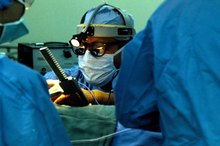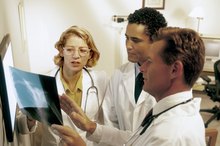What Can You Eat With a Feeding Tube?
Tube feedings are implemented in a medical setting to provide nutrition to individuals who are unable or unwilling to eat. Feedings tubes are placed for a variety of reasons and may be in place temporarily or permanently. Two common types of tube feedings are nasogastric tubes and percutaneous gastronomy tubes. The type of nutrition given to individuals undergoing tube feedings is dependent on the medical needs, body type or allergies.
Types
A nasogastric (NG) tube is inserted through the nostrils and passed through the esophagus to the stomach. A NG tube is used for short-term feeding in instances where the patient is predicted to recover their conscious swallow. A percutaneous endoscopic gastronomy (PEG) tube is placed through the abdominal wall directly into the stomach or jejunum. A PEG tube is used for long-term nourishment to patients who are not able to tolerate food by mouth. Patients may be discharged from the hospital while they still have a PEG tube, which raises many questions about how to provide nourishment.
- A nasogastric (NG) tube is inserted through the nostrils and passed through the esophagus to the stomach.
- A percutaneous endoscopic gastronomy (PEG) tube is placed through the abdominal wall directly into the stomach or jejunum.
Indications
Dobbhoff Feeding Tube Vs. PEG
Learn More
Tube feedings are a medical necessity when individuals are no longer capable or willing to swallow food. Many condition can lead to an individual not having the physical capacity to swallow or the cognition to realize they need to swallow. These conditions include:
- but are not limited to coma
- stroke
- traumatic brain injury
- paralysis,
- malnutrition
Tube feedings must be implemented quickly because dehydration can occur within hours especially with the body undergoing tremendous stress.
Risks and Precautions
The most serious risk associated with tube feeding is aspiration pneumonia due to back up into the esophagus and, eventually, the airway. Pneumonia is a life-threatening medical condition in which foreign substances are inhaled into the lungs. This is prevented by elevating the head of the bed for the patient during and shortly after feedings. This technique utilizes gravity to propel the food down through the small intestines. Additionally, infection is always a risk with a PEG tube because it creates an open wound.
- The most serious risk associated with tube feeding is aspiration pneumonia due to back up into the esophagus and, eventually, the airway.
- Additionally, infection is always a risk with a PEG tube because it creates an open wound.
Types of Nourishment
What Are the Dangers of a Feeding Tube in the Elderly?
Learn More
There are several methods to meeting an individuals needs via a feeding tube. One common way is to puree table food to a liquid consistency. When using this method it is important to include an equal balance of fats, carbohydrates, and protein. Also, the individual must receive necessary vitamins and minerals. For these reasons, it is usually easier to purchase prepackaged products that are specifically designed for tube feedings. Various companies produce liquid formula for tube feedings, but perhaps the most commonly used product in hospitals in Isosource, which is made by Nestle Nutrition.
- There are several methods to meeting an individuals needs via a feeding tube.
- For these reasons, it is usually easier to purchase prepackaged products that are specifically designed for tube feedings.
Considerations
The PEG tube creates an open wound on the individuals stomach. It is imperative that the opening be cleaned daily and monitored for signs of injections. Never pull or push on the tube. Be aware of the tube when dressing because clothing can often catch and pull the tube. The tube should be flushed with clean water before and after each feeding 2. If the individual has diabetes, monitor blood glucose levels before and after each feeding.
Always consult your physician before deciding the best methods and materials for tube feedings.
- The PEG tube creates an open wound on the individuals stomach.
- If the individual has diabetes, monitor blood glucose levels before and after each feeding.
Related Articles
References
- Paz, J. Acute Care Handbook for Physical Therapists. 2002.
- Encyclopedia.com: What Do They Feed People Through A Feeding Tube?
- Sullivan SN. Functional abdominal bloating with distention. ISRN Gastroenterol. 2012;2012:721820. doi:10.5402/2012/721820
- The Oral Cancer Foundation. Nutrition/feeding systems.
- Philpott H, Garg M, Tomic D, Balasubramanian S, Sweis R. Dysphagia: Thinking outside the box. World J Gastroenterol. 2017;23(38):6942–6951. doi:10.3748/wjg.v23.i38.6942
- Blumenstein I, Shastri YM, Stein J. Gastroenteric tube feeding: techniques, problems and solutions. World J Gastroenterol. 2014;20(26):8505-24. doi:10.3748/wjg.v20.i26.8505
- U.S. National Library of Medicine. MedlinePlus. Jejunostomy feeding tube. Reviewed October 29, 2018.
- American Society for Gastrointestinal Endoscopy. Understanding percutaneous endoscopic gastrostomy (PEG).
- U.S. National Library of Medicine. MedlinePlus. Feeding tube insertion - gastrostomy. Reviewed May 20, 2018.
Writer Bio
Clay McCollum began writing professionally in 2010. He was published in the 1999 "Anthology of Poetry by Young Americans." He also presented a research project entitled "EMG responses to commonly performed self-stretches" at the Physical Therapy of Georgia conference. McCollum is currently working towards a Doctor of Physical Therapy degree.









